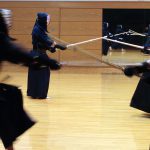
One type of training that all kenshi go through is kakari training. This is a toughest training, and many players feel like “I don’t want to do this”. But there is a reason why everyone goes through such tiring practice sessions. If you engage with kakari practice diligently, you will see your skills improve dramatically over a short period of time. Here I would like to explain the basics of kakari practice, and how you can approach it in order to improve. If you want to improve your kendo, this is a must read!
In kakari practice, there is a “mototachi” (receiver) and “kakarite” (attacker) who form a pair and the attacker strikes non-stop against the receiver. Within 15-60 seconds, the attacker strikes repeatedly with at full force. This requires both physical and mental energy and this is why it is considered the toughest training in kendo.

Why do players endure such tough practice every time? If there is no purpose to it, it simply makes you exhausted… but the good news is kakari practice indeed has 3 specific purposes for improving in kendo.
- By attacking with the initiative, you learn how to look for opportunities to break down your opponent.
- By attacking with full force you gain stamina by improving the function of your heart and lungs.
- You gain to mental strength that allows you to strike with full force within a short period of time.
A beginner may look at this and go “I have no idea what that means”, so I will attempt to summarize it. By attacking with full force during a short period of time, you aim to improve your striking skills and stamina as well as your mental strength that is needed for real matches. Kakari practice aims to improve your physique, technique, and mentality.

But not everyone who does kakari practice gains improvement in physique, technique, and mentality. Since it is very intense, if you approach it the wrong way it can have negative effects. For beginners kakari practice can often be the place where you develop bad habits. There are certain kakari practice patterns that beginners tend to fall into, so it may be good to check that you are not doing these things. If you have not done kakari practice before, read this and try and keep these points in mind. This will help you engage with kakari practice correctly.

Bad Pattern 1: Striking too fast
One thing beginners tend to do is think that “kakari practice is all about striking hard out”. If you only have in mind to strike fast, each strike can be sloppy and you will find yourself off balance. Specifically, your body weight will be too far in front or when you turn around you will strike while your body is still twisted. This can become a habit, and the center of your body will become unstable. This will lead to all your strikes being weak.
How to deal with 1
During kakari practice, keep in mind not only to strike hard but to keep your bodily posture straight. For beginners, you can even strike slowly, but try imagining a straight bar running through your spine, and try to strike without losing that balance. Once you have this down, you can try to strike with increased speed.

Bad pattern 2: Strike with the tip of your hands
During kakari practice, since you are continuously striking many times while swinging your arms. As you get tired, it is easy to develop a habit of striking just with the tip of your hands without swinging your arms. Your strike becomes too light, and during matches it may not be counted as ippon.
How to deal with 2
Try to have the mentality that you are going to get ippon especially when your are tired. Swing your arms properly, with your men, kote, and do altogether. During matches there are scenes where you will be all out striking, but by swinging properly you can make sure you get ippon. As you imaging a real match during kakari practice, the fruit will show in real matches.

Bad pattern 3: Striking without setting yourself in position
Since kakari practice involves continuous striking, many players do not assume the proper position as they strike. When you neglect taking the time to set your position, you may end up striking with the middle part of the shinai or your steps become weak. This may lead to many strikes that are not counted as ippon, and will only drain your stamina.
How to deal with 3
Even during kakari practice, it is important to take the proper pauses. For example, you can easily strike the men from the initial pause, but when you clash bodies with your opponent and hit the men as you withdraw, you should assume the proper pause before you go on and strike the men, kote or do. As you remain mindful of the pauses even during practice, you will learn how to create the necessary pauses effective at your own timing during matches.
 | Did you like what you've just read? Check this out. |








